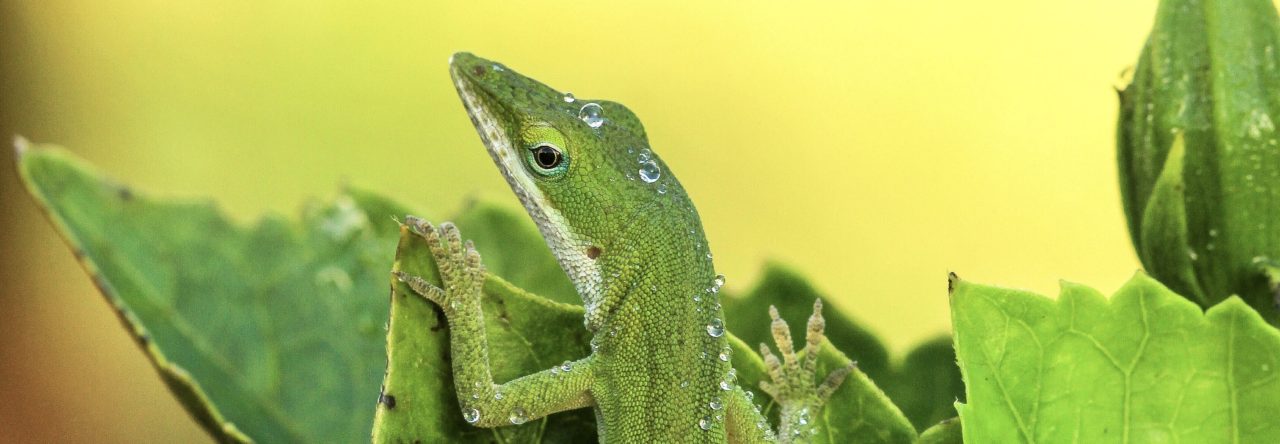Pat Shipman, AA‘s correspondent in the Little Cayman bureau, reports: “We are very familiar with the individuals of A, maynardi that count our house in Little Cayman as their territory. The individual shown here regularly sleeps on our screen porch in the gap at the top of the door. He is shown in May 2011 in the photo on the left. Judging from the landmarks in the photo, his total length was about 23 cm at that time. Early in Dec. 2012, we saw him again and noticed he had lost his tail. By early February–roughly 2 months–he had regenerated about half of his tail (see photo on right). Judging from reported rates of tail regeneration in A. carolinensis, this is rather fast growth. Of course, warm temperatures accelerate growth and the average temperature here year-round is about 85 degrees (Editor’s note: sure, rub it in). We’re trying to get the photos scaled exactly so we can estimate size & growth better, but this seems remarkable.”
I expect that rates of tail regeneration have been reported in anoles, but I don’t know where off-hand. Anybody know of relevant research? Some googling tells us that tail regeneration was a hot topic in the late 60’s and early 70’s and, in fact, there was a paper entitled “Factors influencing rates of tail regeneration in the lizard Anolis carolinensis” by Maderson and Licht (Experientia Volume 24, Issue 10, pp 1083-1086). Am I too lazy to dig out of the internet? Heck no, but apparently it’s not to be found digitally. Sorry! But wait–it is, only you have to look under the journal’s new name, Cellular and Molecular Life Sciences. In any case, here’s the abstract…oops. There is no abstract. But here’s a section from the beginning of the Discussion: “Our results indicate that temperature may influence at least 3 different aspects of the regenerative process…Comparison of results obtained between 21 and 32 °C indicate that the higher temperature accelerates both rates of blastema formation and subsequent regeneration rates. However, the latter process is seen to be considerably more temperature dependent than the former when Q10 values are compared. Finally, temperature influences the final form of the regenerated tail, a smaller proportion being replaced at the lower temperature.”
And, for Pat, here’s the key figure on tail regrowth:
- Evolution in Real Time on Lizard Island - March 23, 2025
- Spider Snags Adult Anolis osa - March 22, 2025
- An Homage to the Green Anoles of New Orleans - March 21, 2025





Neil Losin
I haven’t looked at this systematically (though I probably have the data to do so with both A. sagrei and A. cristatellus), but I did make some measurements on an A. sagrei male back in 2010 that are consistent with the growth rates reported here for A. carolinensis: http://www.daysedgeproductions.com/blog/2010/07/updates-americas-birdiest-county-did-we-win-and-more-tales-of-lizard-tails/
Liam Revell
Here’s a couple of other old references:
Jamison, J. P. 1964. Regeneration subsequent to intervertebral amputation in lizards. Herpetologica 20: 145-149. (http://www.jstor.org/stable/3891036)
Cox, P. G. 1969. Some aspects of tail regeneration in the lizard, Anolis carolinensis. I. A description based on histology and autoradiography. Journal of Experimental Biology 171: 127-150. (http://www3.interscience.wiley.com/journal/110495978/abstract)
The former study compares regeneration after intervertebral tail amputation with regeneration following normal intravertebral autotomy, but in so doing also reports regeneration rates for a number of different lizards, including an anole.
The latter is primarily a histological study of regeneration, but also reports regeneration rates – including under two different temperature regimes (21C and 27C).
– Liam